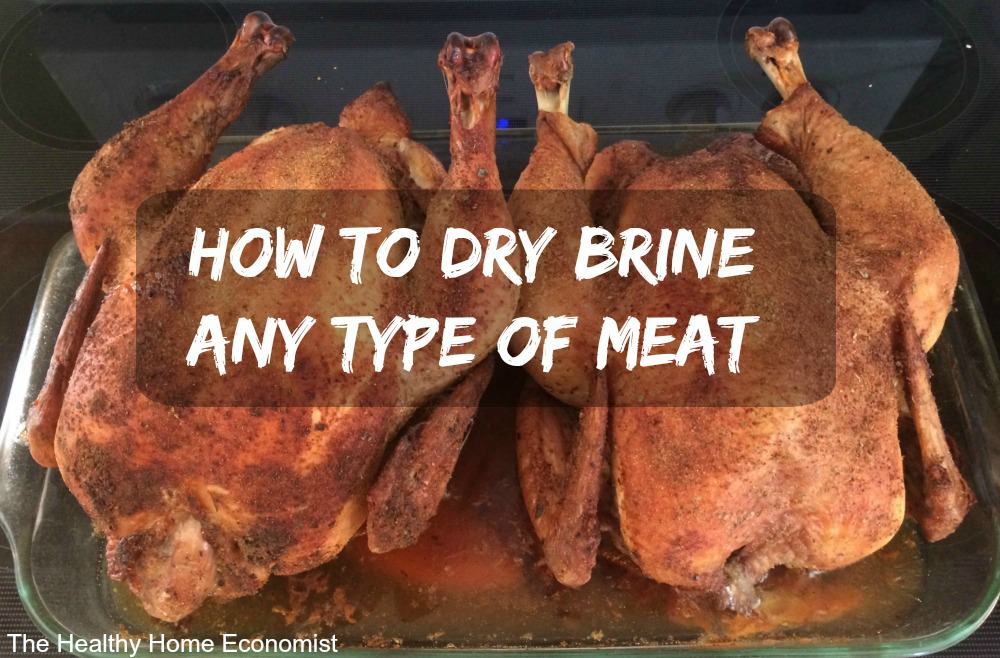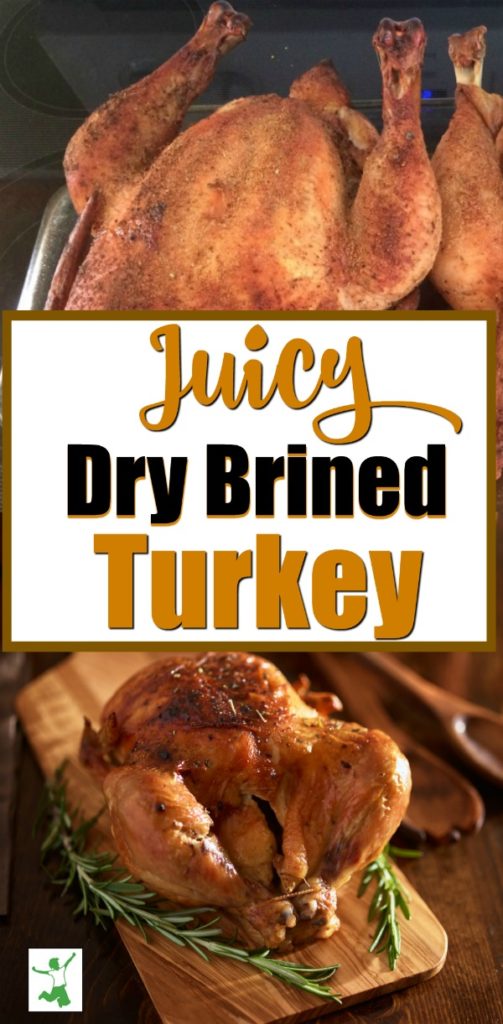This essential and complete guide to dry brining meat with salt, herbs, and spices prior to cooking results in meat that is tasty, juicy and tender when following these easy instructions. 
Years ago, when our family transitioned to locally raised, pastured meats, we had to learn a host of new skills for how to season and cook them. No more store-bought pre-seasoned, saline-injected McNugget mixtures for us! Crockpots, marinades, and wet brining became our thing.
The first year we purchased a local turkey, we were told it would need to be brined.
Brining? What is that, we wondered?
While we are not pirate folk, we figured we could handle putting together a salty bath for our bird. Brining at home is definitely preferable to store-bought poultry (even organic), which is usually injected with an industrial saltwater solution. In other words, “brine” is just a fancy word for saltwater, meaning that when you purchase poultry at the store, you are paying for a bunch of processed saltwater at the same time (and at the same price!) as the meat.
Conveniently, food producers don’t call this process brining, but instead refer to it as “plumping,” perhaps because they are “plumping their pockets” with additional profits from selling saltwater for the same price per pound as the meat itself! Estimates run as high as two billion dollars (yes billion!) per year being pilfered from consumers through this practice.
How much salt water are you paying for? On a large turkey, it can be many pounds worth of water and up to 30% of the total price you pay at checkout. This plumping thing isn’t just standard practice for chicken or turkey either. Some grocery stores and meat processors do it to pork as well. The water weight isn’t the only problem, as the plumped meat you end up eating means you are getting multiple times the USDA RDA (Recommended Daily Allowance)of industrialized salt – the type of sodium you want to avoid.
While Real Foodies know the benefits of real salt, you can bet your bottom dollar that these industrialized injections are the farthest thing from it, with tests showing over 400 to 800 mg per serving of processed sodium.
So, for both your personal health and pocketbook, poultry plumped with injected brine water is problematic to purchase.
Dry vs Wet Brining
Our first pastured turkey weighed in at almost 20 pounds. It required a 5-gallon stockpot to submerge the beast. Some people use food-grade bins or even coolers since the turkey plus water brine takes up so much space. The pot plus brine reached maximum poundage for our refrigerator, and as I carefully placed it on a shelf, I saw and heard the glass protest under the burden. The turkey turned out well and was well praised by guests. But I always remembered and have now read horror stories about the weight of a wet brined turkey shattering glass in many a fridge. What a dangerous mess that would be!
For a few years, we continued wet brining similarly until one Fall day a friend mentioned the traditional technique of dry brining. No massive amounts of water to slosh and spill (or dispose of!). Shorter cooking time. Superior flavor penetration. He ticked off a host of benefits. I was immediately intrigued and set about learning more and preparing to change our holiday practice.
Culinary Alchemy
Dry brining is some sort of culinary alchemy, taking flavors deep into the meat in a most mysterious manner. By coating the outside of a cut with a mixture of salt, herbs, and spices, a set of beneficial reactions ensues.
First, the salt pulls moisture out of the meat! Yes, out.
This may seem like a bad thing at first, but at a certain point, the meat then begins to pull this moisture back in, along with the salt and spice mixture. This pull-push of moisture allows the salt and spices to move deeply into the meat. It also changes the meat’s structure, tightly binding the moisture in its folds and improving the texture.
Benefits
There are four main benefits of dry brining meat versus the more typical practice of wet brining. These include:
- Much shorter cooking time with reductions by as much as one-third.
- Increased resistance to accidental overcooking (meat holds onto its moisture better).
- Superior flavor penetration, since the salt carries herbs and spices deep into the meat.
- Succulent meat texture, no rubbery or watery portions which can sometimes occur with wet brining.

Complete Dry Brining Guide
Intrigued?
Here’s how long you’ll need to dry brine various cuts of meat prior to cooking.
Smaller cuts: 1/2-2 1/2 pounds (steaks, roasts, breasts) – 12-24 hours
Medium cuts – three to eight pounds (whole chickens, large roasts) – 24-36 hours
Large cuts – Greater than eight pounds- 48-72 hours
Also, consider that cut shape matters a lot when dry brining. A longer, wider, but thinner cut will take less time than a rounder, bulkier, more compact cut. So a chuck roast needs less time than an equally sized rump roast. A spatchcocked chicken or turkey will take less time than a whole chicken or turkey. Adjust your brining time accordingly.
Another important note: you will do little harm going longer with your dry brine. The rules above are minimums to help ensure success. If a cut sits an extra day or so, it was never in our experience negatively impacted the meat or meal in any way. As long as you used sufficient salt, herbs, and spices, and the cut was not already older, it should also keep the meat safer than if it was sitting solo.
Steps
Start with a cut of meat that has not been “plumped,” pre-seasoned, pre-salted or otherwise processed in any way. This includes Kosher meat.
- First, make sure the meat is dry. Use a towel or paper towels to remove excess moisture from the meat. In our experience, this is easy with most cuts, except for whole pastured chickens and sometimes turkeys from small, local farms. These tend to have a fair amount of excess water from the water bath chilling process these farmers usually use and may require sitting out for a ten minutes or more on a towel to drain. For chickens and turkeys, this is also the time to remove any organs and the neck if they were tucked into the cavity.
- Next, for each pound of meat, mix 1/4 – 1/2 teaspoon salt and 1/8 – 1/4 teaspoon of herbs/spices for each pound (.45 kilo) of meat. Rub the meat thoroughly all over. Meatier spots need more of the dry brine, so especially focus on poultry breasts.
A few suggestions …
If you have never dry brined before, I suggest before doing it for some special occasion or on some super large cut of meat (like a Thanksgiving turkey or a standing rib roast), to do it on a smaller, similar cut, like a whole chicken or some steaks before moving on up. Since dry brining can use a range on the amount of salt and spices, you can also get a feel for which end of the range you prefer per pound.
Since dry brining changes cooking times, the first few times make sure to keep an eye on your meat. An added bonus to the shorter cooking span means meats take up less time in the oven on busier cooking days, like holidays.
May I suggest that after you dry brine a holiday bird that you roast it in a covered charcoal grill. This article on grilling a turkey contains the recipe. You won’t be disappointed.

Dry Brining Recipe
Basic dry brining recipe for any type of meat or poultry.
Ingredients
- 5 lbs (2.27 kilos) meat preferably pastured
- 1 Tbl coarse sea salt
- 1/2 Tbl Herbs de Provence
Instructions
-
Pat meat dry with paper towel.
-
Thoroughly rub down/coat with brining mixture.
-
Place into a large bag (sources) and seal.
-
Every 12 hours rub meat down through the bag.
-
Dry brine chicken and roasts for 24-36 hours, steaks and smaller cuts for 24 hours, and turkey for 48-72 hours.
Recipe Notes
Adjust sea salt and herb mix used depending on how much meat you will be using: ¼-½ tsp of coarse sea salt and ⅛-¼ tsp of herbs/spices for each pound (.45 kilo) of meat
Dried sage, thyme, rosemary, and marjoram are great herbs to use (organic if possible as non-organic spices are frequently irradiated).
Herbs de Provence is a simple mix to use for dry brining that is delicious. We also love the Thai organic seasoning blend from Frontier, though it is one among many organic seasoning blends you can try and use instead of making your own.
Since the amount of salt and herbs is somewhat up to preference, I encourage people to try out dry brining on some chickens a few weeks before Thanksgiving or Christmas to see what they like best.
Three Reasons to Dry Brine the Holiday Bird
Still not convinced to try it and want to stick with tried and true wet brine? Here’s a summary of the three big reasons to give the dry brine a chance this year instead.
- Takes turkey prep out of the craziness of the big day due to significantly shorter cooking time.
- Removes the danger and potential mess of having a massive, incredibly heavy pot of sloshing water in your fridge. Might even save your back from going out!
- Results in a more evenly and thoroughly flavored bird, with improved moisture and texture.
Pitfalls to Watch Out For
While a much easier process overall, there are a few things to watch out for when you dry brine. Here’s a quick summary of the caveats mentioned earlier.
- Dry brining reduces cooking time so watch the meat carefully.
- Don’t get a kosher (pre-salted) or pre-seasoned and salted turkey. You want a truly au-natural bird.
- Meatier spots need more dry brine, breasts especially.
Will You Give it a Try?
Have you ever dry brined or wet brined pastured meats? If so, please let us know your experiences and what differences you noted between the two methods. Did you prefer one over the other?








Wrapping the bird loosely in cheesecloth or clean linen works just as well as a bag. Keeping the skin of the bird dry is also important, I like to place a cloth-wrapped bird on a wire rack or a few upside down ramekins over a platter or roasting pan while the rub sets. I usually leave this out on the counter for 12 to 24-hrs or in the fridge for 3 days before cooking. The skin always comes out crisp and flavorful, the breast meat is moist and well seasoned. Wrapping in cloth and elevating the meat as it brines is also good to use for beef, pork and lamb roasts and steaks alike.
Does the meat go in the fridge while it is brining or left on the counter?
In the UK we never wet brine fowl. I’d never heard of this practice before until I read about it in an American cook book. The best way to prepare chicken or turkey is to coat it in either butter or olive oil to make the skin nice and crispy, sprinkle it with a generous amount of salt and pepper – plus any herbs or spices you care for. My favourite is paprika but tarragon & lemon or curry or turmeric work well – what ever takes your fancy 🙂 It is important to baste the fowl every now and then as it roasts in the oven. The fowl is ready when no more juices run out of the meat when you prick it with a knife.
I completed my first trial ruin on a smaller piece of free range chicken. It was wonderful and the seasoning had definitely penetrated the whole cut effectively. However, it was a little salty for my taste, making me question whether or not I should have rinsed the meat before cooking? Was I right to leave the spices in place?
Also, I thawed a farm direct chicken from muy local Joel Saladin style farmer and have it dry brined and ready to cook. Sadly my dinner party had to be cancelled and we are heading out of town. Can I just freeze it? Will the brining prices continue? Or should I cook it and then freeze it? Any advice would be great!
Sarah, I too would like some guidance on cooking time besides “less”, and I found the instruction to “rub down the turkey in the bag every 12 hours” rather vague and confusing when combined with Mr. Moody’s random comment about making sure the bag was dry before reusing it? Do you never take the turkey out of the bag? Does the rubbing/massaging of the bird rub off its coating and get it all over the inside of the bag? This would be the perfect candidate for a video demonstration in my opinion.
Thanks – Tonna
Should one put some of the dry brine underneath the skin of a large turkey so it is closer to the meat? Seem to me that the skin would prevent the brine from being absorbed.
The article several times mentions a reduced cooking time. How do YOU know how long to cook your bird for? Just stick a thermometer in a watch? I like to plan a bit more, especially with other items needing to finish at the same time. Thanks for any help, Sarah.
Just make sure when reusing the bag you get it good and dry before putting the meat back in!
Can you suggest a readily available bag source for large birds (>20 lbs.)??? Even those 2.5 gallon Hefty zip bags don’t hold birds that large.
I would suggest using the large bag the pastured turkey comes in from the farm or a clear turkey oven bags like this one: http://amzn.to/2fRrghV
What kind of bag do you use and how do you find one big enough for a large turkey?
Thanks!
Kelly
Hi Kel! How about using the large bag that the pastured turkey comes in from the farm? Or, if that one ripped or is not usable, try the clear turkey oven bags: http://amzn.to/2fRrghV